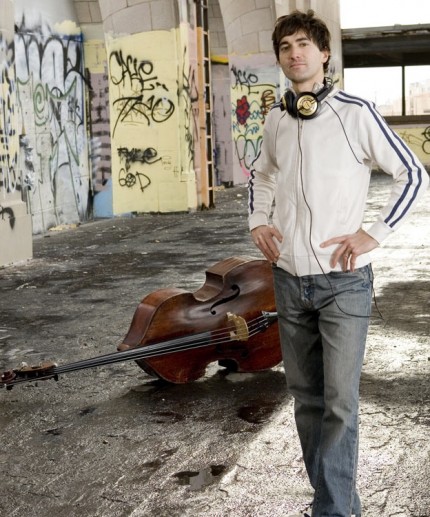Despite dynamic advocacy by Muti and CSO, “Alternative Energy” premiere runs out of fuel

Mason Bates' "Alternative Energy" was given its world premiere Thursday by Riccardo Muti and the Chicago Symphony Orchestra. Photo: Lydia Danmiller
With Riccardo Muti and the Chicago Symphony Orchestra set to embark on a West Coast tour later this month, the orchestra is rolling out a pair of premieres by its composers in residence over the next two weeks. The contracts of both Mason Bates and Anna Clyne were renewed this week for another two years, and each of their new works will be performed on this tour.
Bates, 35, was up first with the debut of his Alternative Energy, premiered by Muti and the CSO Thursday night at Symphony Center.
Scored for large orchestra and Bates’ ever-present electronics, his “energy symphony” is a programmatic, environmentally conscious canvas spanning hundreds of years in four movements. The first section, “Ford’s Farm, 1896” begins in a Midwestern mechanical junkyard. After a brief orchestral introduction, a solo violin plays a rustic fiddle tune, reminiscent of early Americana. An accelerating wooden crank, like that used on early automobiles, sounds a call to arms and the music shifts from an amiable easy-going tempo to a more syncopated urban feel with jazz-inflected clarinets.
The first movement segues without pause to “Chicago, 2012” further charting the development of energy with recordings from the Fermi Lab in Batavia. The mechanistic sounds ping antiphonally from two speakers along with isolated populist fragments and percussion riffs, the orchestra gathering force and building in intensity and rhythmic complexity to a thunderous coda.
In “Xinjiang Province, 2112,” a distorted version of the fiddle tune emerges “on an eerie wasteland,” with the extreme contrasts in dynamics and timbres, painting China’s industrial center erupting into a catastrophic meltdown. This leads into the final section “Reykavik, 2222.” In a mutated environment, a rain forest now exists in Iceland and we hear wooden percussion and recordings of birds as the fiddler returns with distant tribal voices in the background.
Bates’s music is usually most convincing when he has a large canvas to work with as was the case with his The B-Sides, which Muti and the CSO played last May. There is a certain engaging, artless audacity in his writing for orchestra and the electronic element is here fluently melded with the live musicians.
Yet I confess I found much of Alternative Energy overblown, slick and superficial, centered on surface sonic glitz and “hip” populist riffing with little musical substance at its core. Bates’ music is concentrated on pulsing rhythms and shifting beats almost to the exclusion of everything else. Ultimately, that doesn’t have a whole lot to offer over the long term, much less enough to sustain a 25-minute symphony for large orchestra.
Too much of the first two movements sounds like empty vamping for big-band orchestra. (Jazz and the symphony have never really been successfully assimilated unless you’re Gershwin, Ellington or Bernstein, and that’s not the case here.) A swooning melody for celesta and harp in the opening movement sounds like cut-rate John Williams. For all the composer’s much-hyped hipness and electronica DJ background, the music often seems empty and old-fashioned, bouncing along with all the efficient soullessness of a 1970s TV cops show soundtrack.
In the third movement, the writing for piano and high percussion borders on kitsch. The last movement is especially vacuous, loping along with electronic bird noises until it finally runs out of steam in an anticlimactic coda. For all the varied percussion, shifting rhythms, and electronic elements, it’s hard to avoid the feeling that beneath all the hectic surface, there’s no there there.
No complaints about the performance with Muti giving as much complete dedication and meticulous balancing to this score as he would a Verdi opera. The orchestra provided full-metal support for this premiere with special note to Robert Chen’s violin solos and the hard-working percussion ensemble
Franck’s Symphony in D minor is not quite the concert-hall staple it was a few decades ago, possibly due to too many indifferent readings.
Thursday’s performance made one appreciate the symphony anew. Characteristically, Muti brought a wide dynamic palette and refined tonal polish to this uber-chromatic music. The dark, organ-like sonority of Franck’s scoring fits the CSO like a glove and Muti brought out the hymnic qualities well as the bravura brilliance. Aside from intermittent bobbles from the principal horn, the orchestra played gloriously for their music director, with Scott Hostetler’s plaintive and expressive English horn solo a highlight.
In a clever bit of programming, Muti prefaced the Bates premiere with a machine-inspired work from an earlier era, Arthur Honegger’s Pacific 231. Amazingly, this was the work’s first downtown CSO performance since 1930 when Frederick Stock conducted.
With nearly a century of sonic assaults, musical and otherwise, Pacific 231 has lost much of its original shock value and can seem almost quaint today. Muti led a vital performance of Honegger’s aural train-spotting that bracingly portrayed the slow startup, gradual acceleration and mechanistic cacophony.
The program will be repeated 8 p.m. Friday and Saturday and 7:30 p.m. Tuesday. cso.org; 312-294-3000.